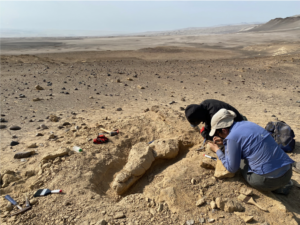In order to investigate the influence of shrimp farming activities on carbon and nutrient accumulation, sediment cores were collected from two areas at different distances from shrimp farms within a Peruvian mangrove ecosystem. In both areas two sediment cores were collected in a transect, one from a mangrove-covered site and one from a mudflat site. At both study sites, the isotopic values of carbon and nitrogen as well as the C:N molar ratios suggest that the highest carbon accumulation rates were linked to terrestrial-derived organic matter, with higher carbon stocks and fluxes within mangrove-covered zones. The historical records indicate that since the mid-1970′s, the areas nearest to the shrimp farming activity have been accumulating higher proportions of algal derived organic matter, which were likely triggered by the high nutrient influx derived from shrimp farming effluents. The carbon and nutrient fluxes were up to threefold higher within the area nearest to the shrimp farms, whereas the geochronologies showed that the carbon and nutrient stocks in this area increased by up to twofold. The results showed that mangrove-covered zones are more capable to keep pace with sea level rise (SLR) as compared to the mudflat zones, indicating the importance of mangrove vegetation in terms of the vulnerability of this region to SLR and an ongoing capacity to continue accumulating sediments. This study highlights the role that mangrove vegetation plays in mitigating the impact of shrimp farming activities, accumulating carbon and nutrients in pace with SLR.



